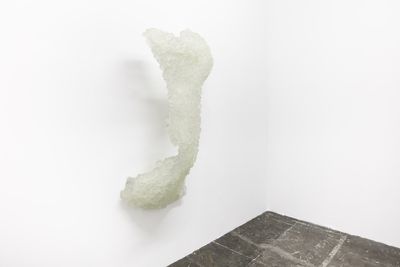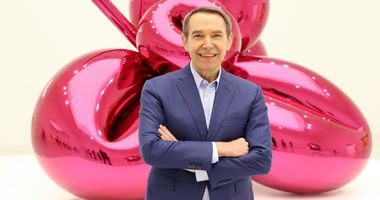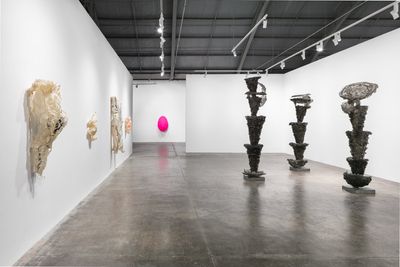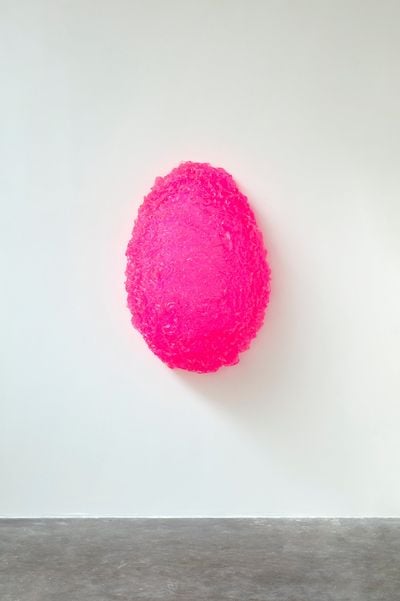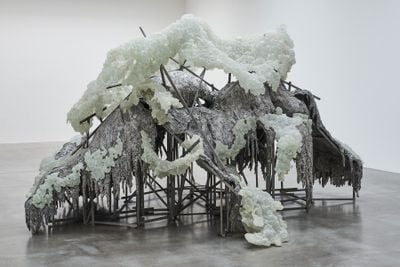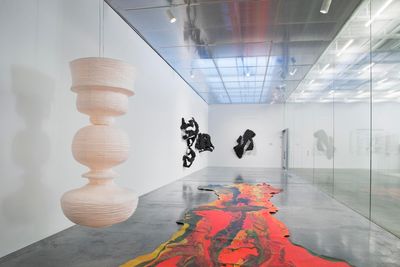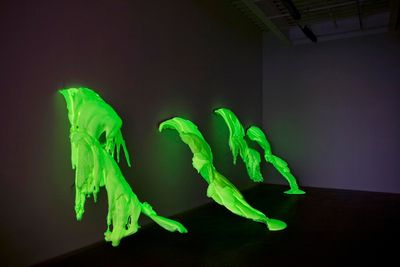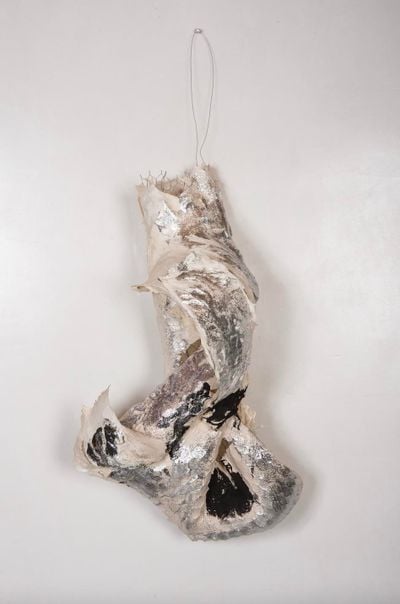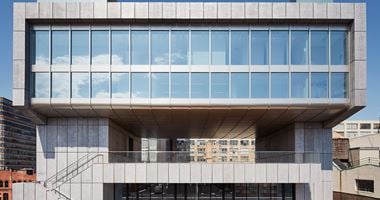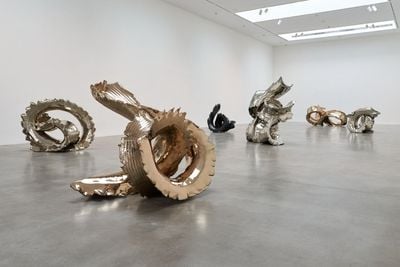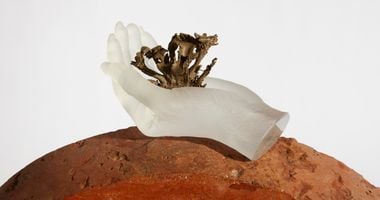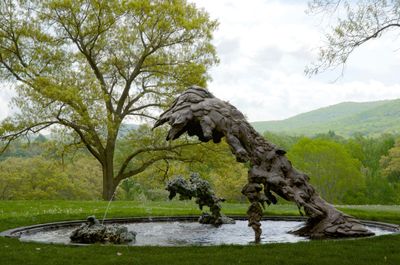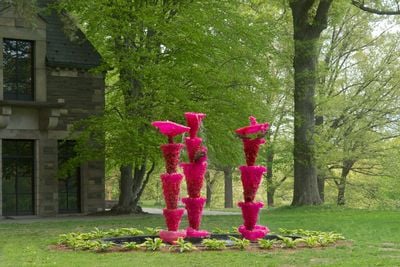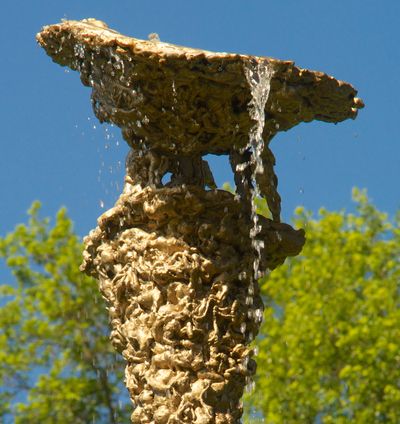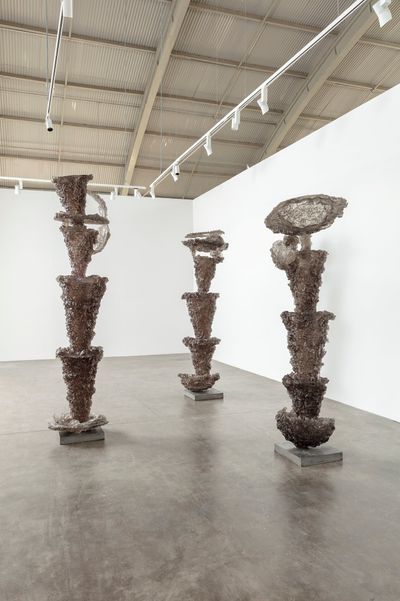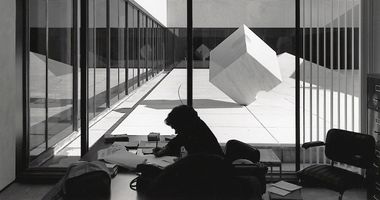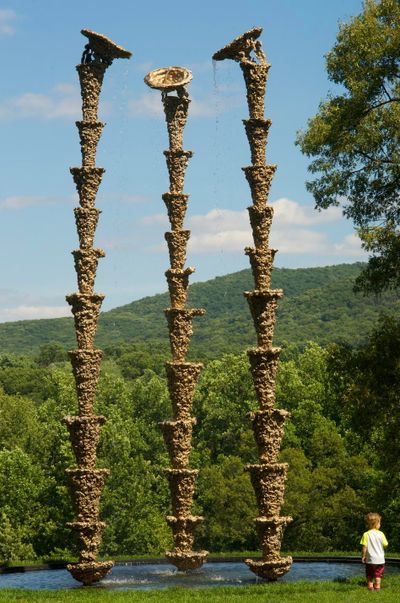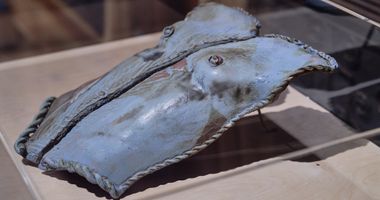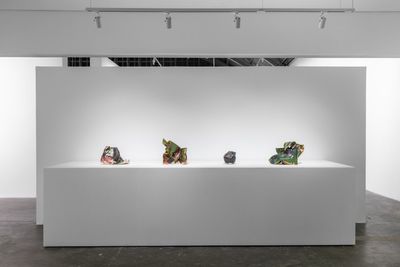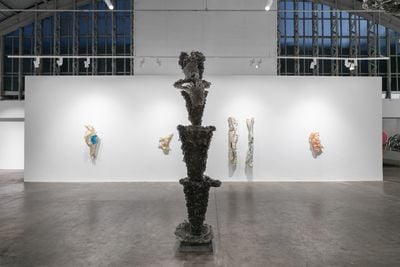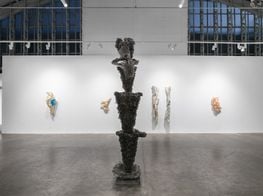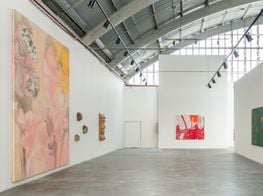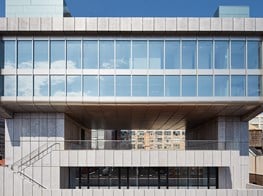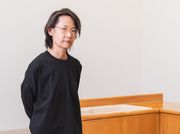Lynda Benglis: Sculpture on Its Own Terms

Lynda Benglis, Choctaw (2013). Glazed ceramic. 26.7 x 35.6 x 33 cm. Courtesy Mendes Wood DM.
One image of Lynda Benglis is undeniably iconic: a forever infamous ad that ran in a 1974 issue of Artforum, preceding Jeff Koons' self-promotional spreads in the magazine by over a decade.
Benglis is seen naked, displaying very of-the-time tan lines, sporting white cat-eyed sunglasses and an androgynous mullet. ('My intention was to mock the idea of having to take sexual sides,' Benglis said.1) She's grasping a massive double-dildo like it's her own cock and looking at the camera like she's asking what it wants to do about it. ('The ultimate mockery of the pinup and the macho.' 2)
The ad polarised the art world, writes critic Richard Meyer. 'Apparently outraging five of the six associate editors of Artforum, two of whom (both women) resigned.' John Baldessari said it was the best page they've ever run.3
Benglis said her 'sexual mockeries'—the name of the audio and visual works Benglis created in the 1970s around pornography—intended to satirise 'the art-star system, and the way artists use themselves, their persona, to sell the work'.4
Like a spectral icon, that 1974 image of Benglis charges the artist's practice in the way that Derrida said a signature stands in for an oeuvre. In this case, sculptures that make bold use of materials, from early pigmented wax paintings utilising a blow torch, to polyurethane foam cast into bronze.
Born and raised in Louisiana, Benglis, 80 this year, was always fascinated by 'how things became material', from building treehouses—recalling the pile of cast phosphorescent polyurethane slabs over stainless steel scaffolding, Hills and Clouds (2014)—to baking cakes. 'For me, everything was plastic. Mutable.'5
She trained at Newcomb College in New Orleans, and moved to New York in 1964, working at a gallery and enrolling at the Brooklyn Museum Art School.
'I wanted to know those artists who were part of what I considered art history,' she recalled. Among them, minimalist colourfield painter Helen Frankenthaler, postminimalist sculptor Eva Hesse, hard-edge painter Bridget Riley, and the usual suspects: Judd, LeWitt, Rauschenberg, and Warhol.
The artist developed her signature 'Fallen Paintings' in the late 1960s—brightly pigmented latex rubber poured on the floor to create three-dimensional paintings once the liquid solidifies—followed by the globular 'Pours' in the 1970s, Day-Glo pileups of pigmented polyurethane foam that the artist would later cast.
The results are often described as being in conversation with Pollock—'Had Pollock been alive,' Benglis said, 'I would have met him'6—while taking Abstract Expressionist action painting further and elsewhere.
Benglis' original and novel approach to matter and form was amplified in Phantom (1971), included in the artist's first retrospective in New York at the New Museum in 2011; five green phosphorescent pigmented polyurethane foam sculptures splayed out from the wall like visitors materialising from the other side.
As Benglis stated in a 1970 issue of LIFE featuring Henry Groskinsky's 1969 photo of Benglis making a floor painting: 'I realised that the idea of directing matter logically was absurd. Matter can and will take its own form.'7
The 'Knots' series, begun in the 1970s, mediates this intuitive process with pleated ribbons and conical ropes made from wire mesh, cotton bunting, plaster, sculpt metal, and vaporised metals, or gold leaf, like the candy-wrapper column, Knossos (1978).
Later knots use cast glitter—applied in pastel multicolour blocks to Back Bone (2017), a crumple of chicken wire-mounted handmade paper. ('I love paper. It's like skin,' the artist has said.8)
Born and raised in Louisiana, Benglis, 80 this year, was always fascinated by 'how things became material'...
Benglis staged Metallized Knots at Paula Cooper Gallery in New York in 1974 (4–29 May). The exhibition announcement was an Annie Leibovitz photograph: Benglis stands with her back to the camera, naked with jeans crumpled at her booted ankles, looking straight to viewers.
Of the image, Benglis said: 'I've always sought to push things to their contextual limits, be it my own likeness or the medium of painting or sculpture.'9
This comes through in Lynda Benglis, the artist's exhibition at Nasher Sculpture Center in Dallas (21 May–18 September 2022), where handmade paper works are shown alongside bronze enlargements of ceramic curls, like those included in the 2021 Pace Gallery show in New York—An Alphabet of Forms (5 May–2 July).
The Nasher show also spotlights Benglis' fountains, which she started creating in 1983—a natural extension to a practice engaged with alchemical questions of material solidity.
Winning a design competition for the Louisiana World Exposition, Benglis created The Wave (The Wave of the World) (1983–1984), a terrifying bronze wing that seems to rush out of the water like Hokusai's famous The Great Wave (1831) rendered in hard lava. Her first bronze cast.
Other fountains followed: Crescendo (2015), shown at Storm King Art Center for Water Sources (16 May–8 November 2015), which extended The Wave by pouring more polyurethane material onto the original fountain and recasting it.
Benglis compares the result to 'a snail on top of another thing, making its home,'10 calling back to Pink Ladies (2014), another fountain whose pockmarks Benglis associates with foamy sand patterns created by burrowing Louisiana crawfish.
Composed of stacked cones made from hot-pink polyurethane blooms pushed out from a pressurised dispenser, these columns—as if David Medalla's 'Cloud Canyons' (1964–2016) were caught mid-transmogrification into Brancusi totems—stand at just under three metres.
Their colour is inspired by a kite Benglis saw with Asha Sarabhai, after whom a third column is named, during a festival in Ahmedabad. (Benglis has continued returning to India since a residency with the Sarabhai family in 1979.)
These forms are replicated in The Graces (2003–2005), a trio of indoor columns made from translucent cast polyurethane tinted an ethereal, Fragonardian lavender, which speaks to the women the sculptures allude to.
They seemed to froth into the Museum of Cycladic Art in Athens for In the Realm of the Senses (22 November 2019–15 March 2020) organised by NEON, presenting 36 sculptures alongside a photo of the Greek-American artist as a child wearing the traditional uniform for male Greek freedom fighters.
Another trio of columns illuminates the colour study happening in Benglis' casts, showing how tone (in every sense) can shift through material filters. Black Ice (2009) is a leaden, cast pigmented polyurethane trinity of stacked conical stems.
Taking the form and colour of a bubbling, smoky explosion, Black Ice recalls the artist's take on Noguchi's Akari paper lamps: the four-metre-tall Bikini Incandescent Column (2014), whose shape melds a woman's body, a phallus, and a mushroom cloud to allude to America's nuclear testing on Bikini Atoll.11
Black Ice appears in Benglis' first solo show in Latin America with Mendes Wood DM in São Paulo (Frozen Gestures, 9 April–29 May 2022), with works from the last 13 years. Among them Ohkay Owingeh (2012), a bird-like paper abstraction, and ceramic works like Choctaw (2013), with clay slabs fired with splatters of glaze.
Using an industrial extruder and working by hand, Benglis has been working with ceramics since the 1990s. A decade that also saw a series emerge combining stone slabs with cast and ceramic sculptural forms, like the bronze coils rising from slate in Snakemare III (1991).
Invoking the subtle magnitude of a scholar's rock, these are but another running chapter in an ever-evolving artistic trajectory. All of which returns to that 1974 image of Benglis, and the two aesthetic tracks defining her practice.
As Benglis told Baldessari in 2015: 'When I look back at work I've made in the past, it's as if I'm visiting another time, another place, and sometimes another artist.'12
In the 1970s, Benglis said she created video and photographic works as her own feminist protest. Female Sensibility (1974) is close-up film of her kissing friend Marilyn Lenkowsky, and Now (1973) screens Benglis on one side of the T.V. engaging with her pre-recorded mirror image on the other. (In 1975, the Fine Arts Center Gallery at the State University of New York College at Oneonta, staged a survey of Benglis' video works that travelled to Stedelijk Van Abbemuseum in Eindhoven.)
But ultimately, it's an affair with matter that has sustained her. 'I spend quite a bit of money just on materials,' she told Baldessari, recalling the time she waitressed in New York and blew her earnings on 500-pound vats of Day-Glo pigments.
With that, while the eminent critic Robert Pincus-Witten coined the oft-cited term 'the frozen gesture' to describe Benglis' art in 1974, the Mendes Wood DM show proposes a rewrite. (Despite taking that term as title.)
The curatorial release emphasises the five decades Benglis spent focused on 'material innovation and engagement with movement, light, space, form, and surface', during which the artist's gestures have become 'unfrozen, multiplied, or otherwise complicated'.
It's an apt way to look at this life's work; a movement of material transformation that did what it had to do to make space for sculpture and matter to speak on their own terms. As Benglis said herself: 'most artists prefer not to be categorised, as they believe themselves to be ever-changing. I certainly think of myself like that.' —[O]
1 Hermione Hoby, 'Lynda Benglis Pours One Out', Frieze, 26 February 2020, https://webcache.googleusercontent.com/search?q=cache:cN2jp4ZybdEJ:https://www.frieze.com/article/lynda-benglis-pours-one-out+&cd=12&hl=en&ct=clnk&gl=uk&client=firefox-b-d.
2 Richard Meyer, 'LYNDA BENGLIS', Artforum, Volume 43, November 2014, https://www.artforum.com/print/200409/lynda-benglis-7803.
3 Richard Meyer, 'LYNDA BENGLIS', Artforum, Volume 43, November 2014, https://www.artforum.com/print/200409/lynda-benglis-7803.
4 John Baldessari, 'Lynda Benglis', Interview Magazine, 22 March 2015, https://www.interviewmagazine.com/art/lynda-benglis.
5 Hermione Hoby, 'Lynda Benglis Pours One Out', Frieze, 26 February 2020, https://webcache.googleusercontent.com/search?q=cache:cN2jp4ZybdEJ:https://www.frieze.com/article/lynda-benglis-pours-one-out+&cd=12&hl=en&ct=clnk&gl=uk&client=firefox-b-d.
6 John Baldessari, 'Lynda Benglis', Interview Magazine, 22 March 2015, https://www.interviewmagazine.com/art/lynda-benglis.
7 'Lynda Benglis. Frozen gestures', meer, 12 April 2022, https://www.meer.com/en/69260-lynda-benglis-frozen-gestures.
8 Lynda Benglis, Artforum, Volume 12 no.8, September 2012, https://www.artforum.com/print/reviews/201207/lynda-benglis-31976.
9 Richard Meyer, 'LYNDA BENGLIS', Artforum, Volume 43, November 2014, https://www.artforum.com/print/200409/lynda-benglis-7803.
10 'Lynda Benglis Water Sources', Storm King Art Center, unknown, https://stormking.org/exhibitions/benglis/crescendoetc.html.
11 Anny Shaw, 'Lynda Benglis: the globe-trotting artist who shocks and delights', Financial Times, 17 January 2020, https://www.ft.com/content/600e7886-330a-11ea-a329-0bcf87a328f2.
12 John Baldessari, 'Lynda Benglis', Interview Magazine, 22 March 2015, https://www.interviewmagazine.com/art/lynda-benglis.


